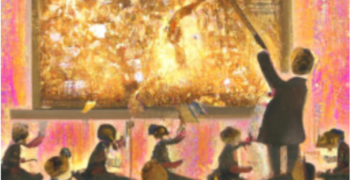The Writing Four of Common Core
Common Core Tip of the Week #4
by
Megan Faux
Writing? What I am supposed to be teaching?
The sentiment has been the same for many teachers, young and old, in regard to their feelings on teaching writing. There are too many skills, not enough time, and no clear curriculum to do it. To add fuel to the fire, there are a new set of writing standards that teachers still may not be used to. Just when you have gotten used to the old, in comes the new. When you mix a new set of standards with the already scary task of teaching writing, there’s fear, plus anxiety plus frustration. The task becomes all the more elusive, but it doesn’t have to be. The Common Core Standards require all grades to write in the same genres. This is especially helpful when students are not at grade level. You simply go back to go forward. The Common Core writing standards are set up in 4 parts that I affectionately call ……
The Writing Four of Common Core
1) Text Types and Purpose refer to the writing genres students are expected to produce.
2) Production and Distribution speak to the finished product and the process used to get there. This section of the standards includes the writing process and finished products that incorporate the use of technology.
3) Research & Presentation of Knowledge integrates reading, reading standards, background knowledge, the ability to digitally research information, synthesize information and, cite sources when writing.
4) Range of Writing specifies the frequency of writing and the various time frames and conditions in which students should be writing.
Text Types and Purpose
- Text Types and Purposes – All students in grades K-12 must write to the following three genres. This model lends itself to building a strong writing foundation.
- Opinion (K-5) Arguments (6-12) – Students must state an opinion and provide evidence to support their opinion.
- Informative/Explanatory – Students are required to explain or provide information on a topic backing up their informative writing piece with definitions, visuals, headings, and more
- Narrative – Students are required to give a narrative or an account (true or false) of a scenario using colorful details and the features of storytelling.
PRODUCTION AND DISTRIBUTION OF WRITING
- Production and Distribution of Writing – All students are to produce writing in which development and organization are appropriate to the task (i.e. opinion, informative, narrative)
- Grades 2 and 3
- Produce multiple-paragraph writing in which development and organization is appropriate to task (i.e. opinion, informative, narrative)
- Grades 4 and beyond
- Improve writing with support and suggestions from adults and peers. This is the new Writing Process (planning, revising, editing*)
- Use technology including interne and keyboarding to produce writing.( Grade 4 and beyond must be able to type one page in a single sitting. )
3). Students must interact and collaborate during the writing process activities.
RESEARCH AND PRESENTATION OF KNOWLEDGE
III. Research and Presentation of Knowledge -All students are required to conduct research and present their knowledge.
- Conducting short research projects using several sources
- Recall, gather and provide information from print and digital sources
- Cite a list of sources Beginning Grade
- students draw evidence from literary or informational text to support reflect and research
⮚ Describe characters, setting, events
⮚ Explain how he author uses reasons, and evidence to support particular points in a text
⮚ Identify which reasons and evidence support which points.
Students must write daily, 4-6 times a day.
IV. Range of Writing – All students must engage in various forms of writing multiple times throughout the day.
- They write over extended time frames allowing time for research, reflection and
- They write over shorter time frames as in one sitting one to two days.
- Forms of writing should include subject-specific tasks and various purposes.
In a nutshell
These writing standards provide an easy way to intervene when students are not meeting grade-level expectations. This is because students are required to pretty much do
the same things grades K-12. If they can not do what is required of them, then take them back a step so they can master the prerequisite skill. Meet them where they are and then move them forward. Sometimes we have to go backward to go forward. Just think of it this way. The goal is PROGRESS.
















